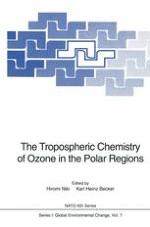1993 | OriginalPaper | Buchkapitel
Reactions of Halogen Species on Ice Surfaces
verfasst von : David R. Hanson, A. R. Ravishankara
Erschienen in: The Tropospheric Chemistry of Ozone in the Polar Regions
Verlag: Springer Berlin Heidelberg
Enthalten in: Professional Book Archive
Aktivieren Sie unsere intelligente Suche, um passende Fachinhalte oder Patente zu finden.
Wählen Sie Textabschnitte aus um mit Künstlicher Intelligenz passenden Patente zu finden. powered by
Markieren Sie Textabschnitte, um KI-gestützt weitere passende Inhalte zu finden. powered by
Halogen species play critical roles in the chemistry of ozone in the stratosphere. The roles played by bromine and chlorine in stratospheric ozone destruction via catalytic cycles have been studied extensively. These halogen species may also be important in the ozone chemistry of the Arctic troposphere [Barrie et al. 1988]. In particular, bromine chemistry has been implicated in the observed episodic destruction of tropospheric O3 in the Arctic spring. Such an O3 loss could be due to the liberation of bromine from inactive to active forms [Barrie et al., 1988; McConnell et al., 1992]. Conversion of inactive halogen species such as the hydrogen halides, chlorine nitrate, and bromine nitrate to forms that are capable of affecting the concentrations of tropospheric O3 are likely to take place over the ice surfaces which are present during polar winter and early spring. Yet, the heterogeneous processing of bromine compounds on ice surfaces has not been studied. Therefore, we have carried out a series of laboratory measurements to investigate the reactive and non-reactive uptake of atmospherically important halogenated species such as ClONO2, BrONO2, HCl, and HBr onto ice layers located on the inner wall of a cylindrical flow tube at 200(±10) K.
